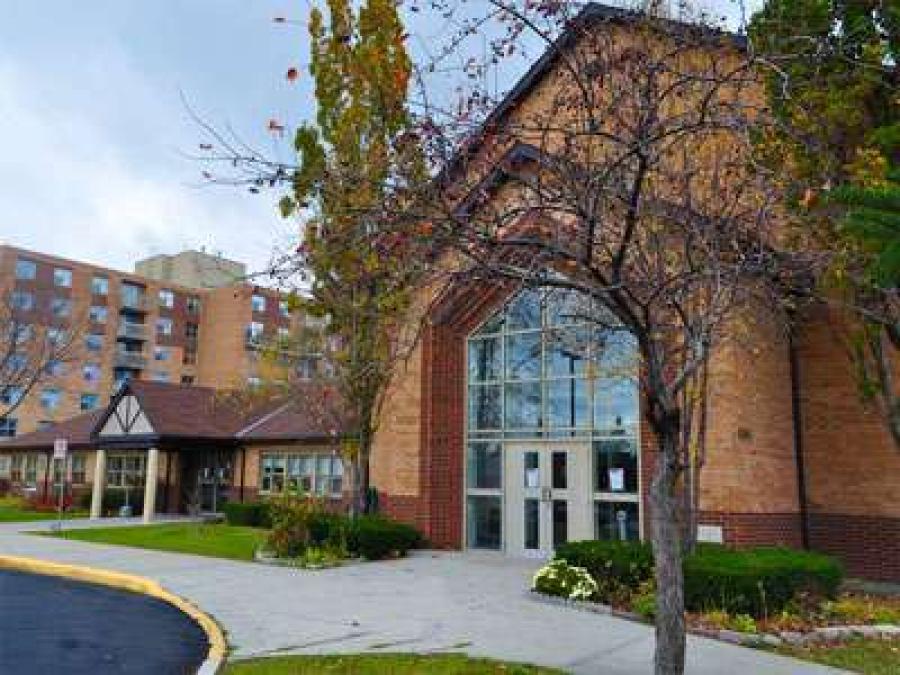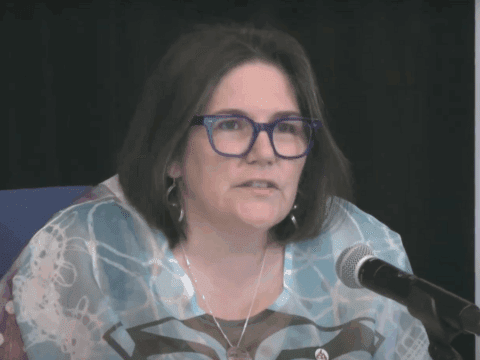Visible through the tall sanctuary windows of Westminster United, the 68-unit Tomken Grove non-profit apartment building is a source of satisfaction for the congregation. It’s a tangible sign of the church’s mission to help its Mississauga, Ont., neighbourhood. Since being built 26 years ago on church-owned land, the professionally managed and well-funded building has provided low-income residents with affordable places to live. The church benefits, too: the proceeds from the 40-year land lease funded construction of the congregation’s own building in 1991. When the lease is renewed in a few years, the church will get another infusion of cash.
Affordable housing is on the wish list of many United Church congregations that are trying to do good while keeping the doors open. They’re looking to trade what they have — valuable real estate — for renewed church space and longterm funding. Many also opt for partnerships with commercial or condominium developers. Land represents a huge opportunity for a church in transition, but great ideas and good intentions may not always be enough. Wading into property development can be risky without specialized guidance and professional help.
Last year, a national property inventory laid out the value and redevelopment potential of real estate currently held by United Church congregations. The inventory was funded with $300,000 from the Canada Mortgage and Housing Corporation in return for a church commitment to try to generate at least 1,000 new affordable homes. N. Barry Lyon Consultants (NBLC) carried out the project on behalf of the General Council’s EDGE network for new and renewed ministry.
The network “never imagined getting involved in property work” when it was formed in 2011, says Rev. Rob Dalgleish, EDGE’s executive director. Four years later, however, a survey of United Church congregations found that 30 percent expected to sell or redevelop their sites in the near future. Now, nine congregations are looking into working with EDGE and its consultants on property redevelopment. EDGE real estate planning co-ordinator Kris Tavella says he has fielded hundreds of queries about property issues.
Estimating the church’s more than 3,000 properties to be worth about $1 billion, the NBLC report identified 215 with “strategic real estate value” that would be beneficial to redevelop. More than half of these are located either in the lower mainland of British Columbia or in the Toronto to Hamilton area of Ontario. Properties in rural areas or smaller cities, it says, are not worth developing but can be sold for fair prices on the open market.
The report also points out that the church needs to do a “missional review” in addition to financial analysis, looking at the health of congregations and future property needs.
Currently, pastoral charges considering property sales or development do that on their own, often without help from development professionals or other consultants.
The consultants highlighted seven strategic sites, all in Ontario. The sites aren’t currently being developed, but the report looked at how they could be developed and what the projects might be worth. Most would have housing units rented or sold in the open market rather than with affordable rates, but all seven examples show that well-managed redevelopment could pay big financial dividends. In three Toronto project concepts, projected revenue from straightforward land sales ranges from $4 million to $50 million. The estimated long-term income potential of the same sites — if the church participated in the development instead of simply selling — ranges from $8 million to $78 million. If money can fuel mission, urban church property redevelopment shows plenty of potential for generating it.
The United Church’s newest affordable housing project reveals what a committed pastoral charge and patient volunteers can do even without sky-high property values. United Church property in Miramichi, N.B., didn’t make the list of 215 “strategic sites” in the NBLC land inventory, but a $3.3-million, 24-unit seniors’ apartment project broke ground there last fall. It’s the result of almost eight years of work by Prince Place Inc., a non-profit corporation founded by the Newcastle (N.B.) pastoral charge.
The project came together with lots of collaboration. The pastoral charge funded the purchase of land and encouraged people in the community to donate more, and the city contributed land as well. Overall, the church invested $450,000 in the initiative (to be paid back by housing income over the next two decades), and the rest of the down payment came from a $480,000 grant from a federal-provincial affordable housing program. The New Brunswick-based UNI Financial Cooperation credit union provided the mortgage, and a provincial government agency will subsidize rent for 12 of the apartments.
As members of the congregation and its community age, says Prince Place board member Gwen Geikie, “good, clean, affordable” apartments are hard to find. “It’s part of our outreach to help the community at large and our church community as well,” she says. She expects residents — already on a waiting list — to move into the one- and two-bedroom apartments, located beside the church and near downtown, later this year.
Along with a glimpse of potential profits from redevelopment, the NBLC study also points out its challenges. One is that every pastoral charge and its trustees must make their own decisions on property. Presbyteries have oversight, but “they also lack the capacity or expertise to guide real estate projects or validate strong decisions.” The report confirms what a few churches have learned the hard way: congregational volunteers going it alone without specialized professional help rarely succeed in the complex financial, regulatory and political environment of urban development.
Failed deals provide cautionary tales. In Halifax, St. John’s United planned a complex of seniors’ apartments. But to keep the housing affordable, the project needed more unit density than its zoning in a downtown neighbourhood would allow. The complex fizzled, and the building has now been sold to a private developer.
In Toronto, Wesley Mimico United worked for almost seven years to redevelop its church but was already running hefty budget deficits at the outset. The project was cancelled after winding up about $1.5 million short when delays due to heritage, planning and zoning ate into the building’s $17-million budget. The property was sold to a local Montessori school.
In Kelowna, B.C., members and staff of St. Paul’s United planned to redevelop the church site into a $20-million arts, worship, retail and condo complex. But the effort was halted in 2016 because of a funding shortfall, almost two years after the church had been torn down. The property has been sold, and the congregation now worships in a rented space in another church.
Not every redevelopment led by congregational volunteers fails. Vancouver’s Dunbar Ryerson United, for example, recently got approval for a multimillion-dollar venture that will include renewed church and community space, market-rate condos and affordable housing. However, says the congregation’s co-ordinating minister Rev. Debra Bowman, volunteer project leaders include legal, business and real estate professionals who have worked on similar projects.
To help congregations get the guidance they need, the NBLC report suggests the United Church should create eastern and western regional property resource groups to offer in-house expertise.
A good model for how this could work already exists in British Columbia Conference. About six years ago, after two years of consulting congregations — many already seeing dwindling membership and revenue alongside soaring real estate values — the Property Resource Team was formed. It hopes to help congregations “assess and transform property value in ways that will enable and empower mission priorities.” The team includes Conference staffperson Terry Harrison, who is a changemanagement specialist, and professional real estate consultants from Colliers International.
Harrison says B.C.’s real estate boom gives congregations with deteriorating buildings and depleted funds a way to maintain a Christian presence in their neighbourhoods. After years of leading congregational discussions and negotiating with municipalities, lenders and developers, the team has seven redevelopment projects underway. Two are under construction, two are likely to break ground this summer and three more are almost ready to go.
The projects fall into two categories. The first is “market” redevelopments, where the congregation contributes its land or the right to develop it and gets a new building and cash in return. “We bargain hard and make sure it is well negotiated,” says Harrison.
The second redevelopment category, affordable housing, currently includes four B.C. congregations that will get 31,500 square feet of rebuilt church space and at least 400 units of affordable housing, with a combined budget of about $145 million.
The four projects will be built by British Columbia Conference through its Property Development Council, with backing and financing from BC Housing, and development management by Colliers International. Along with a new church space, each congregation gets ongoing annuity income from the affordable housing, which will be owned by a Conference-based incorporated society that will hire property managers.
Harrison says putting all four projects into a single portfolio to qualify for BC Housing financing means that smaller projects — which would not be feasible on their own — can also take part. Two additional congregations may join the group.
But just because the Property Resource Team works well in the province, says BC Conference executive secretary Rev. Doug Goodwin, that doesn’t mean its approach will apply across the church. “Each area is going to be quite different,” he says, “with different government and extra-government commitments and resources, with different development needs, models and players in the industry.”
British Columbia’s high property values are making mission goals possible, says Harrison. “It’s not [about asking] where can we get richest,” she says, “but where can we use the riches to continue being and doing church in the 21st century in new and meaningful ways.”
This story first appeared in The Observer’s April 2018 edition with the title “Working the land.”














